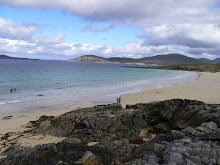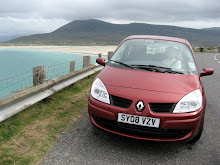Travelling south, the next island in the Outer Hebridean chain is Harris which is divided into North and South parts. Peat remains a major source of fuel for many homes and signs of its collection were common.


Sheep are an integral part of life on these islands. Every day, as we drove along, there were sheep in the fields and on the roads. They were mainly of the black face variety, but we also recognised Cheviot sheep as well. All of them had long shaggy wool and there appeared to be little evidence of shearing. Jan explained that when the wool reached a certain length it broke off and the coat fell off the animal often dragging behind it like the train of a wedding gown.






The island of Harris has given its name to the coarse cloth woven from its sheep. Harris Tweed has been popular among farmers and hunters for many years. The harsh nature of the cloth is lessened by removal of some of the oil carried in the wool. Traditionally, the oil was removed by soaking the cloth in urine - human matured urine that had been collected from the crofter's family and guests to the croft. Other methods are used today and the tweed no longer has its customary odour!
A highlight of our trip was our 2-night stay at the Ceol na Mara Guest House in Tarbert. Mr. & Mrs. Mitchell were gracious hosts and welcomed us to their home perched on a hill overlooking a small loch. Everything was first class including the delicious breakfast cooked to ordered. It featured the best black pudding we have tasted!





From Tarbert along a side road to the west coast of North Harris we drove along the bank of Loch Siar and found more extensive white beaches and even a private castle with the public road running through its front garden. The road ended at Hushinish with its Caribbean-like beach setting, but the wind was cold and strong.





At the southern tip of South Harris in the town of Rodel stands the 16th century church of St. Clement. It was built by Alasdair McLeod and it contains his tomb. From its tower there was a great view of the Sound of Harris which separates this island from the Uist islands to the south.




The Tomb of Alasdair McLeod

The Sound of Harris and the Uists in the Distance
By this stage in our journey we had expected to be the victims of the local midges, those tiny "no-see-um" insects that bite and irritate. Many signs warned of the problem and offered help. Fortunately, perhaps due to the continuing strong winds, we saw not one midge. 
For Part 3 - click on the following link:
http://www.hebrideanholiday3.blogspot.com/

